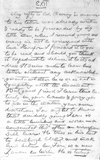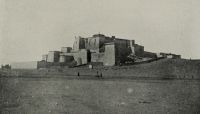Mahatma Letter No. 86
| Quick Facts | |
|---|---|
| People involved | |
| Written by: | Koot Hoomi |
| Received by: | A. P. Sinnett |
| Sent via: | unknown |
| Dates | |
| Written on: | unknown |
| Received on: | late September 1882 |
| Other dates: | unknown |
| Places | |
| Sent from: | Phari Jong monastery |
| Received at: | Simla, India |
| Via: | unknown |
This is Letter No. 86 in The Mahatma Letters to A. P. Sinnett, 4th chronological edition. It corresponds to Letter No. 112 in Barker numbering. See below for Context and background.
< Prev letter chrono
Next letter chrono >
< Prev letter Barker
Next letter Barker >
Page 1 transcription, image, and notes
|
My reply to Colonel Chesney in answer to his letter was already written and ready to be forwarded by my little man, when I received yours advising me not to correspond with him. Therefore I forward it to you to be read, and should you think it expedient — to deliver it to it's address. It seems rude to leave his letter without any acknowledgment — whether he is or is not in sympathy with the movement. But good friend I leave this entirely in your hands and pray you to use in the matter your own discretion. You ought to know that decidedly young Fern is a little humbug and worse — a congenital though often an irresponsible liar. He tries in his last to bamboozle M. and make him believe he, Fern, is a new Zanoni en herbe. He is testing |
NOTES:
|
Page 2
|
us in every way and manner and constant skirmishes notwithstanding has a certain and very strong influence on Hume, whom he bamboozles with imaginary "powers" whose mission is to supplant the Brothers. He made him believe indirectly he belonged to a Society whose "name is unmentionable" a Society that seeks no one, whose one member knows not who the other is, nor will he know till the real nature of the "Brothers" is made public, though the system on which it works precludes all deception, etc. etc. To M. he writes that he confesses he "ought not to have put temptation" in his (Hume's) way. For having over estimated his strength, he has "unwittingly caused him to fall."!! This individual is at the bottom of much |
|
NOTES:
|
Page 3
|
that has happened. Watch and beware of him. One thing is certain though. These are not times for visiting with severity the offences of the too indiscreet and but half faithful "lay chelas". Now that Mr. Hume alienated the Chohan and M. I remain alone to carry on the difficult work. You read H.'s letter. How do you like that huge shadow of a Yogi with solemnly stretched out hand, and defiant haughty eyes disavowing with contemptuous gesture the intent of hurting the Society. Let me echo your sigh for the poor Society, and before fading away again into the foggy distance between Simla and Pari Jong assure you of my ever friendly feelings for yourself, |
|
NOTES: |
Page 4
|
Mr. W. Oxley wants to join the Eclectic. I'll tell her to send to you on his letter. Kindly write to him to say that he must not feel vexed at my denial. I know he is thoroughly sincere and as incapable of a deception or even exaggeration as you are. But he trusts too much to his subjects. Let him be cautious and very guarded; and, if he joins the Society I may help and even correspond with him through you. He is a valuable man, and indeed, more worthy of sincere respect than any other Spiritualistic mystic I know of. And though I have never approached him astrally or conversed with I have often examined him in thought. Do not fail to write to him with the first steamer. |
NOTES: |
Context and background
This letter was sent from Phari-Jong Monastery in Tibet.
Physical description of letter
The original is in the British Library, Folio 3. According to George Linton and Virginia Hanson, the letter was written:
On a folded sheet of smooth bluish colored paper, about 5" x 8 1/2" [12.7 x 21.6 cm], in blue pencil,with grained appearance.[1]
Publication history
Commentary about this letter
Notes
- ↑ George E. Linton and Virginia Hanson, eds., Readers Guide to The Mahatma Letters to A. P. Sinnett (Adyar, Chennai, India: Theosophical Publishing House, 1972), 145.




